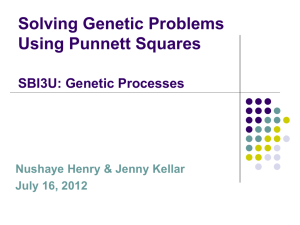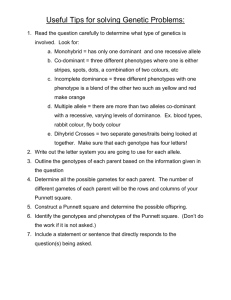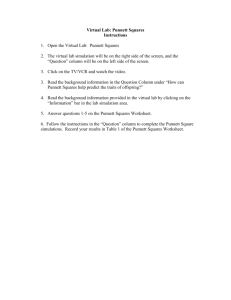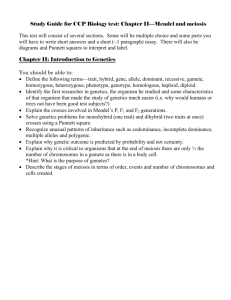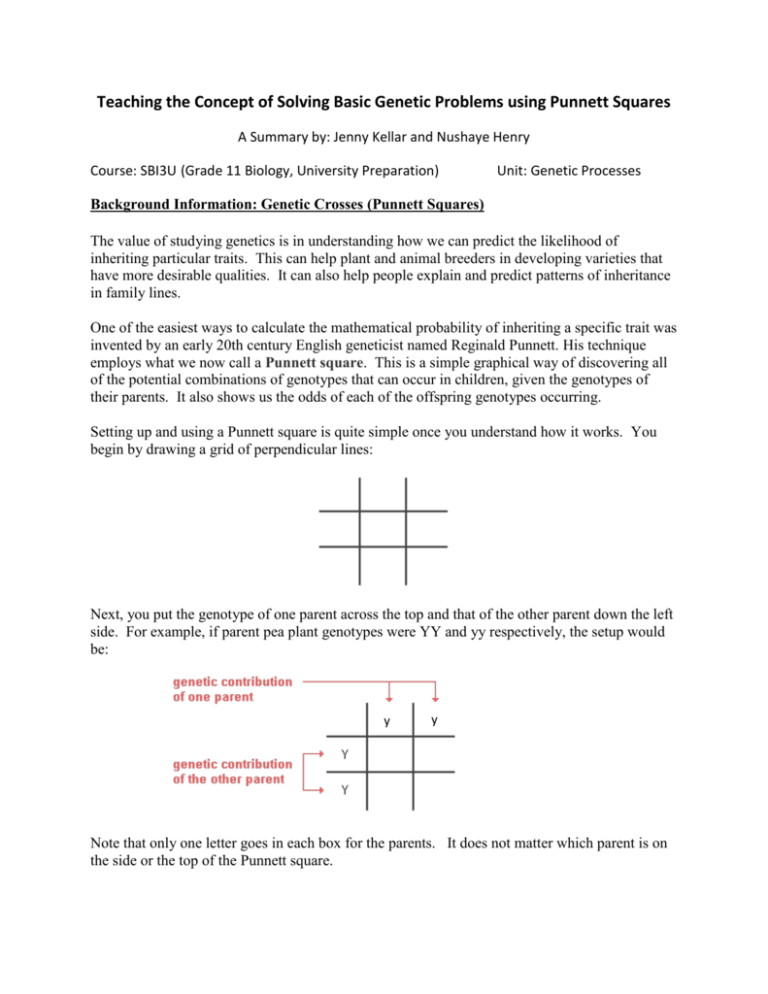
Teaching the Concept of Solving Basic Genetic Problems using Punnett Squares
A Summary by: Jenny Kellar and Nushaye Henry
Course: SBI3U (Grade 11 Biology, University Preparation)
Unit: Genetic Processes
Background Information: Genetic Crosses (Punnett Squares)
The value of studying genetics is in understanding how we can predict the likelihood of
inheriting particular traits. This can help plant and animal breeders in developing varieties that
have more desirable qualities. It can also help people explain and predict patterns of inheritance
in family lines.
One of the easiest ways to calculate the mathematical probability of inheriting a specific trait was
invented by an early 20th century English geneticist named Reginald Punnett. His technique
employs what we now call a Punnett square. This is a simple graphical way of discovering all
of the potential combinations of genotypes that can occur in children, given the genotypes of
their parents. It also shows us the odds of each of the offspring genotypes occurring.
Setting up and using a Punnett square is quite simple once you understand how it works. You
begin by drawing a grid of perpendicular lines:
Next, you put the genotype of one parent across the top and that of the other parent down the left
side. For example, if parent pea plant genotypes were YY and yy respectively, the setup would
be:
y
y
Note that only one letter goes in each box for the parents. It does not matter which parent is on
the side or the top of the Punnett square.
Next, all you have to do is fill in the boxes by copying the row and column-head letters across or
down into the empty squares. This gives us the predicted frequency of all of the potential
genotypes among the offspring each time reproduction occurs.
y
y
Yy
Yy
Yy
Yy
In this example, 100% of the offspring will be heterozygous (Yy). Since the Y (yellow) allele is
dominant over the y (green) allele for pea plants, 100% of the Yy offspring will have a yellow
phenotype, as Mendel observed in his breeding experiments.
Important Vocabulary:
Monohybrid cross: A genetic cross of two individuals that differ by one trait. Usually, these
two individuals are true breeding for this trait and are considered the P (parent) generation. Only
one trait is monitored and hybrid offspring (the F1 generation) are produced. Example: tall peas
x short peas or TT x tt
Dihybrid cross: Hybridization in which two traits with two alleles each are examined.
Example: tall peas with round seeds x short peas with wrinkled seeds or TTRR x ttrr
Dominant: The form of a trait that always appears (is expressed) when an individual has an
allele for it. Usually denoted with a capital letter. In the example above, the allele for the
dominant yellow colour is expressed with a capital Y.
Recessive: The form of a trait that only appears when an individual has two alleles for it. Usually
denoted with a lowercase letter. In the example above, the allele for the recessive green coour is
denoted with a lowercase y (because yellow is dominant).
Codominance: A form of inheritance in which both alleles are equally expressed. The phenotype
is not a blend of the two traits.
Blood typing is a great example:
AB blood is the result of a codominant relationship between the A protein and B protein both
expressing themselves completely. The genotype is IAIB.
AO (type O allele means there is no protein), A is dominant and you see type A phenotype. The
genotype is IAi.
BO is the same except you see the B phenotype. The genotype is IBi.
Type O is recessive, therefore the individual has two recessive alleles, producing the genotype ii.
*The ABO blood typing system is also an example of a trait with multiple alleles because there
are more than two variations of the trait.
Incomplete dominance: this is a form of inheritance in which the heterozygous alleles are both
expressed, resulting in a combined (or blended) phenotype.
Many books use the example of flower colours. If a red flower (RR) and a white flower (WW)
are crossed, a pink flower (RW) is produced. If it were codominance, you would see both the red
and white colors, perhaps in splotches. Incomplete dominance is most commonly found in plants.
Sex Linkage: A particularly important category of genetic linkage has to do with the X and Y
sex chromosomes. These not only carry the genes that determine male and female traits but also
those for some other characteristics as well. Genes that are carried by either sex chromosome are
said to be sex linked.
If a woman is a carrier of an X-linked recessive
allele for a disorder and her mate does not have it,
their boys will have a 50% chance of inheriting the
disorder. None of their girls will have it, but half of
them are likely to be carriers.
dominant allele = A
recessive allele = a
If a man has an X-linked recessive disorder and his
mate does not carry the allele for it, all of their girls
will be carriers. None of their boys will inherit the
harmful allele. Only girls receive X chromosomes
from their fathers.
Advance Preparation/Teaching Ideas
Prior to learning about the use of Punnett squares to analyze genetic crosses, students should
have knowledge of Mendel’s experiments, including understanding of a monohybrid cross from
Mendel’s true-breeding crosses, what the P (parent) generation, first filial (F1) generation and
second filial (F2) generations are, the Law of Segregation, the Law of Independent assortment
and the meaning of genotype, phenotype, dominant, recessive, homozygous and heterozygous.
Resources that could be used in teaching the above concepts include Biology 11 (section 5.1), or
an interactive online source such as Interactives: DNA or DNA from the Beginning. These
resources are all listed in the Additional Resources section at the end of this document.
To introduce this concept, the teacher will use a Power Point presentation. Prior to class the
teacher should set up a computer and LCD projector with the Power Point presentation that the
students will be viewing. The students will meet in the computer lab instead of the science lab
and so the teacher will put up a sign on the door reminding them where their class will be. This
will be done before class begins. In addition, the teacher will need to ensure that all handouts
have been printed for student use.
The Introduction to the lesson (Power Point presentation) is about the students getting to know
themselves based on their own genetic make-up. It asks them a series of questions on whether
they are right or left- handed, if they can roll their tongue or not, or even if they have black, grey
or blue eyes and so on and to state the dominant and recessive genotype. Each student will be
given a Get to Know Yourself worksheet (attached at the end of this document) as he/she enters
the class and takes his/her seat and they will be told by the teacher that they only need a pen or a
pencil for the task. The teacher will then begin the power point presentation from her computer
which will be projected on the screen or the whiteboard. Students will answer questions
throughout the presentation about their own genetic make-up, their possible genotypes, and learn
which alleles are dominant and recessive. After viewing the presentation and answering
worksheet number one. The teacher will then have an overall discussion linking their previous
knowledge with the activity that they had just done.
After the discussion is finished, the teacher will introduce a Gizmo called Mouse Genetics (One
Trait). This Gizmo partially addresses expectations D2.3 and D2.4. It reviews key vocabulary
related to genetics and introduces the use of Punnett Squares to make predictions about
offspring. The web address of the site, the title of the computer simulations and instructions on
finding the Gizmos would have already been placed on the white-board for them to follow after
they have logged onto the computer. Before the students begin their simulations the teacher will
review the instructions that are on the white-board and demonstrate the Gizmo using the
computer and overhead projector. The students will complete the accompanying Student
Exploration worksheet independently or with a partner (this would be dependent on the number
of computers). The teacher will always be walking around, guiding them, answering questions,
helping those students who need help ensuring they follow the instructions correctly, and
assessing understanding through the activity.
When the students have completed the Gizmos simulations, they will be asked to complete the
five question assessment on the website. The teacher will be able to use this assessment data to
check for understanding. In addition, the students will be asked to hand in their completed
worksheets. If time allows at the end of the period, the teacher will summarize the activity with a
brief class discussion.
Curriculum Expectations:
By the end of this lesson sequence, students will be able to:
D2.1 Use appropriate terminology related to genetic processes, including, but not limited to:
haploid, diploid, spindle, synapsis, gamete, zygote, heterozygous, homozygous, allele,
plasmid, trisomy, non-disjunction, and somatic cell
D2.3 Use the Punnett square method to solve basic genetics problems involving monohybrid
crosses, incomplete dominance, co-dominance, dihybrid crosses and sex- linked genes
D2.4 Investigate through, lab inquiry or computer simulation, monohybrid and dihybrid
crosses and use Punnett square method and probability rules to analyze the qualitative and
quantitative data and determine the parent genotype.
Lesson Sequence:
This is an abstract concept that requires the students to practice a number of types of genetic
problems on paper as well as using computer simulations and virtual labs to fully comprehend
the concept. Therefore a number of lessons will be planned to accomplish this. They are as
follows:
Lesson1: Introduction to Punnett Squares
Use of “Get to Know Yourself” Power Point and accompanying worksheet to review
relationship between phenotype and genotype, and dominant and recessive alleles
Use of the Mouse Genetics (One Trait) Gizmo to review vocabulary and introduce
Punnett squares
Assessment: Online quiz, worksheets handed in
Lesson 2: Monohybrid Crosses continued/Introduction to Dihybrid
Teacher led discussion about discoveries made through the use of the Gizmo
Explicit review of the Punnett Square to ensure everyone understands
Pencil and paper practice – worksheet or textbook questions
What happens if we want to examine more than one trait? (Intro to dihybrid crosses)
Lesson 3: Solving Dihybrid crosses with Punnett Squares
Assessment for learning: Entrance Quiz: Monohybrid crosses
Use of Online Mix Those Genes game from The GEEE! In Genome website
Lesson 4: Complex Patterns of Inheritance Co-dominance, Incomplete Dominance and
Multiple Alleles
Assessment for learning: Entrance Quiz: Dihybrid crosses
Use of Power Point and practice problems from Genetic Traits in Harry Potter to
introduce and the practice these concepts using Punnett Squares
Additional focus placed on blood types
Lesson 5: Sex-Linked Traits
Assessment for learning: Monster Genetics Lab
Use of Punnett squares to solve problems involving sex-linked traits
Related genetic disorders (although this is the end of the lesson sequence on Punnett
Squares, this lesson could be the jumping off point for study of social and ethical issues
surrounding genomics, reproductive technologies, etc).
Potential Student Difficulties and Possible Solutions
The difference between codominance and incomplete dominance can be difficult for
students. Using real life examples is often effective in clarifying these two patterns of
inheritance. Last year I had a student in my class who had one Caucasian parent and one
African-Canadian parent – he used himself as an example of incomplete dominance
because he had a skin colour that was a blend of his two parents. The rest of the class
immediately understood, and used that student as an example on assessments throughout
the year!
Initially, students can find the use of uppercase and lowercase letters to represent
dominant and recessive alleles rather than two different letters (for example T to
represent tall, and t to represent short, rather than using T and S) confusing. Proper
modeling by the teacher and continued practice will help them to use proper notation.
The use of superscript notation when solving problems that involve complex patterns of
inheritance adds another level of difficulty to Punnett squares – students often find the
switch from uppercase/lowercase to superscript a big step. Again, proper modeling by the
teacher and continued practice will help them to use proper notation. It’s also important
to ensure that the resources students are given to help them use proper notation, as not all
sources do.
Instructional Modifications for Diverse Learners
Those students who are auditory learners will spend more time on computer simulations and
virtual labs where they can listen attentively while completing various genetic problems. They
will do more individual work than group work as a part of their instruction on interactive labs.
Following assessment, students who do not understand the abstract aspects of genetic problems
using Punnett squares will work in small groups with the teacher for additional instruction while
the rest of the class moves on with more difficult problems.
Other alternative instructional strategies for diverse learners could include more problem
solving practices of Punnett squares using multi-sensory teaching approaches such as Gizmos
and advance organizers.
Instead of consistently being placed into one specific group, students with different learning
needs will consistently move throughout the various groups, depending upon their strengths.
We would have more visual interactive lessons so those students who struggle with the English
language can have the opportunity to understand fully without having to battle with too many
written answers. There will also be a word board and flash cards with the terms and their
meaning on it so that they do not struggle to find the meaning which can be a challenge for them.
During computer simulations, ELL students would be paired with a student who has strong
English skills and is able to speak their first language to ensure they understand the instructions.
Differentiated Assessment
Throughout this lesson progression, student learning will be assessed through the use of short
entrance quizzes and their work on online activities. Students will be able to demonstrate their
knowledge on paper, on the computer, and through verbal discussions in whole class settings and
one-on-one with the teacher. Teachers will use student results on these assessments to guide
instructional strategies and support students who are having difficulty mastering concepts.
Power Point presentations with illustrations will be used for introduction and lesson development
to show the concepts visually, and students will be assigned questions and answers to complete
so they are able to practice the concepts.
Students will also keep journals (learning logs) using a variety of methods. For example, they
can jot down their new facts and ideas about the concepts followed by their thoughts and
reflections, or they can keep a log of what they know and what questions they still have about the
concept.
Student learning will be evaluated through a unit test as well as a culminating task at the end of
the unit. In preparation for the task, the teacher will brainstorm with the whole class, small
groups and individual students (KWL). Students will write a news release linking celebrities and
what their offspring would look like when crossed with another celebrity or regular citizen.
Following a brief explanation, students will create an informational brochure or other product
that demonstrates their knowledge of all lessons from the concept. Those students who love to be
active (kinesthetic), or listen to music (auditory) can do their own informational song, poem, rap
or cheer, create flow charts (visual), show a step by step process (logical), put on an
informational commercial (linguistic) or create a game such as Jeopardy, focussing on a part of
the concept or a general overview of the concept.
Applications and Societal Issues/Implications
This topic is hugely applicable to every student as they are all products of genetic crosses! Many
students are really excited about this topic as the concept of Punnett squares itself is fairly
simple, but the applications are so interesting. They are all curious about why they look the way
they do and why they aren’t identical to their siblings. Genetics have been applied throughout
history as humans have developed different breeds of dogs, varieties of vegetables, colours of
roses and domesticated animals to work for them. A particularly interesting article in National
Geographic article delves into a long running experiment in which wild foxes were strategically
bred until they became domesticated like dogs (see reference below).
Although Punnett squares themselves don’t raise any societal issues, their use can be used to
solve questions of paternity or maternity (I used the Justin Bieber case of accused paternity in my
class last year) and to make predictions about future children (genetic screening).
Within this unit, the study of the ethical issues surrounding genomics and reproductive
technologies are all very current issues that are in the news almost everyday. The use of recent
news stories, movie clips (such as Gattaca or My Sister’s Keeper) and debate in the classroom
are all ways to get students interested in the societal issues that surround research related to
genetics today. In addition, prepared case studies could be used to explore these ethical issues –
the University of Buffalo’s Case Study collection includes a number of cases that are applicable
to this unit on topics such as cloning, genetic disorders, and genetically modified organisms (see
website below).
Annotated References:
http://www.tes.co.uk/ResourceDetail.aspx?storyCode=3001332
This is the TES website and it is one of the world’s largest online networks for teachers. It has
more than 2 million resources that are downloaded from the TES website and is home to more
than 400,000 individually crafted teaching resources developed by teachers for teachers, this
unparalleled collection helps to guide, inform and inspire educators around the world. This site
provides worksheet on all the genetic crosses to accompany lessons being developed.
Virtual lab: Punnett squares
Glencoe.mcgraw-hill site:
http://glencoe.mcgraw-hill.com/sites/dl/free/0078802849/383934/BL_05.html
This virtual lab compliments the lesson and it links the recommended textbook that students use
in the science class. Students are able to carry out various investigations in a short time that
would not allow for them to do so otherwise. The results, through investigation, are in a virtual
lab where students construct and analyze Punnett squares for monohybrid genetic crosses given
various scenarios describing specific Drosophila crosses.
Probability of Inheritance:
http://anthro.palomar.edu/mendel/mendel_2.htm
Any additional resource materials such as lessons, information, games and flashcards linking the
lessons and providing vocabulary words and their meanings can be found and printed from this
site. Games here can be used in general or they can be used for specific lessons from the
expected outcomes stated above. It was Created and maintained by Dr. Dennis O'Neil Behavioral
Sciences Department, Palomar College, San Marcos, California. Copyright © 1998-2011 by
Dennis O'Neil. All rights reserved.
Biology 11: Teacher's resource. (2011). Toronto, ON: McGraw-Hill Ryerson.
This teacher’s resource, which accompanies the grade 11 biology text book published by
McGraw-Hill Ryerson, is a great source for Black Line Masters and additional questions to
compliment the material in the text book.
DNA From the Beginning. (2010). Retrieved from http://www.dnaftb.org/
Similar to an online text book, this site provides illustrations, text and animations of 75 key
concepts organized in 3 categories - Classical Genetics, The Molecules of Genetics (DNA and
RNA), and Genetic Organization and Control. This site could be used by students for
independent introduction or review of concepts.
Dunlop, J., et al. (2010). Patterns of Inheritance. In Biology 11 (pp. 200-239). Toronto, ON:
McGraw-Hill Ryerson.
This textbook is included on the Trillium List, meaning that has been approved by the Ontario
Ministry of Education for use in teaching the 11U biology course. Chapter 5 (Patterns of
Inheritance) includes the use of Punnet Squares to solve genetics problems.
Genetic Traits in Harry Potter. (2011). Retrieved from
http://www.nlm.nih.gov/exhibition/harrypottersworld/science.html
This lesson plan is a teacher resource created to compliment the U.S. National Library of
Medicine’s travelling exhibition Harry Potter’s World: Renaissance Science, Magic, and
Medicine. The lesson plan can be adapted for students in grades 7-11 and for students who have
little knowledge of Harry Potter. The lesson plan provides background information, a readymade lesson presentation in Power Point or PDF form, teacher background information, and
student handouts. The activities cover genetic vocabulary, Mendelian and complex forms of
inheritance, and the use of Punnett squares to solve genetic problems. The practice problems and
Monster Genetics Lab referred to above can be found on this website.
Gizmos. (2012). Retrieved from http://www.explorelearning.com/
There are three Gizmos that relate directly to the concept of Punnet Squares - Mouse Genetics
(One Trait), Mouse Genetics (Two Traits), and Chicken Genetics which focuses on co-
dominance. Each activity includes a teacher’s guide, vocabulary list, student worksheet and 5question assessment. Each is an inquiry-based lesson plan that allows students to work at their
own pace to solve genetic problems and learn about inheritance.
Interactives: DNA. (2012). Retrieved from
http://www.learner.org/interactives/dna/index.html
The Genetics section of this interactive website gives an overview of Mendel’s experiments and
the use of Punnett squares to solve problems that involve monohybrid crosses, sex linkage and
multiple alleles (blood types). Students are able to read through the text at their own pace and
attempt the problems. Once they have submitted their answers they are deemed to be correct or
incorrect and are given a second attempt before the correct answer is revealed. The other sections
of this Interactive would be useful in teaching other topics in genetics.
National Centre for Case Study Teaching in Science. (2012). Retrieved from:
http://sciencecases.lib.buffalo.edu/cs/
This website contains an enormous collection of case studies appropriate for teaching science at
the high school and postsecondary level. It is searchable by discipline, age level and specific
topic. Some case studies have been adapted for use with clickers in the classroom, some require
additional research, and others stand alone. Two cases which would be appropriate for use in the
Genetic Processes unit of the Grade 11 Biology course are Bringing Back Baby Jason: To Clone
or Not to Clone and A Sickeningly Sweet Baby Boy: A Case Study of Recessive Inheritance in
Inbred Populations.
Ratliff, E. (2011). Taming the Wild. National Geographic, 219 (3). Retrieved from:
http://ngm.nationalgeographic.com/2011/03/taming-wild-animals/ratliff-text/1paid
This article describes a long running experiment in which wild foxes were domesticated though breeding
– eventually they had floppy ears, wagging tails and a desire to be paid attention to by humans. It
discusses genotype with relation to phenotype and is an interesting application of genetics.
The GEEE! in Genome. (2008). Retrieved from http://nature.ca/genome/index_e.cfm
This website was developed by the Canadian Museum of Nature to accompany its exhibition,
The GEEE! In Genome, which explored genomics (the study of genes and their functions), the
contributions of Canadian scientists to the field, and the surrounding ethical issues. The website
includes information about genes, heredity, uses of genomics (including genetic disorders, stem
cell research, genetic testing, and GMOs), scientists, and a collection of online games and
activities appropriate for student use. The online game Mix Those Genes, allows students to
choose a mother and father and complete a dihybrid cross for eye colour. Attached at the end of
this document is a worksheet designed to be completed with this game. Note: the sound effects
are a bit racy, but the content is good – my senior students have always laughed the sound effects
off. Macromedia Flash or Shockwave is in order to see the online games.
Additional Resources:
There are two resources attached at the end of this document. One is the Get to Know Yourself
worksheet referred to in the lesson plan above, the other is a worksheet that can be used with the
Mix Those Genes game on The GEEE! In Genome website.
The Gee in Genome -- http://nature.ca/genome/index_e.cfm
Go to "Try it" and then "Online Games" ' go to "Mix Those Genes"
Click on "More Information" to answer the following questions:
1. What are the genes that control eye color called? ______________ and ________________
2. Which color is always recessive? _________________________
3. Identify the colors for each of the genotypes:
BBGg = __________________________ bbGg = _____________________________
Bbgg = __________________________ bbgg = _____________________________
Go to "Choose Parents"
4. What are the genotypes of your three potential mothers and their eye colors (phenotypes)?
Name
Genotype
Color
Jane
Jill
Jem
Choose a mother, to go to the next page:
You chose ______________________ (name)
5. What are the genotypes of your three potential fathers and their eye colors (phenotypes)
Name
Genotype
Color
Rick
Ron
Rex
Choose a father, to go to the next page:
You chose ______________________ (name)
Insert the genotypes of the parents you chose here: ___________ X ____________
6. Click on the "Make Babies" to show your offspring. -> Click on "More Babies" to see all 16.
How many babies of 16 have: Brown eyes _______ Blue eyes ________ Green eyes_______
What percentage of babies have: Brown eyes _______ Blue eyes ________ Green eyes_______
7. Follow the same procedure to pick new parents. You chose: ________________and ________________
How many babies of 16 have: Brown eyes _______ Blue eyes ________ Green eyes_______
What percentage of their babies have: Brown eyes _______ Blue eyes ________ Green eyes_______
8. Now do the squares! What will happen if you cross Jane (BbGg) and Rex (bbgg)? FILL OUT THE
PUNNETT SQUARE to make your prediction.
Below each genotype, fill in the
offspring’s phenotype (AKA eye
colour).
10. Run the simulation to see their offspring. How many Jane and Rex babies out of 12 have:
Brown eyes ____________ Blue eyes ____________Green eyes _______________
What percentage of their babies have: Brown eyes _______ Blue eyes ________ Green eyes_______
11. Compare Punnett data to Simulation Data.
Simulation (program) -out of 4
Punnett Square (above) - out of 4
% Blue
% Green
% Brown
12. In your own words, describe how the Punnett square is a useful tool for genetics.
NAME:
Get to know yourself – fill in the table using the presentation to help you.
Question
Do you have dark or light hair?
Are you right or left handed?
Is your ear lobe free or attached?
Do you have freckles?
Can you roll your tongue?
Are your little fingers curved or straight?
Do you have brown or blue eyes?
Which arm is on top when you cross them?
Is your thumb curved or straight?
Is your second toe longer than your big toe?
Answer
Dominant/
Recessive
Possible Genotype


